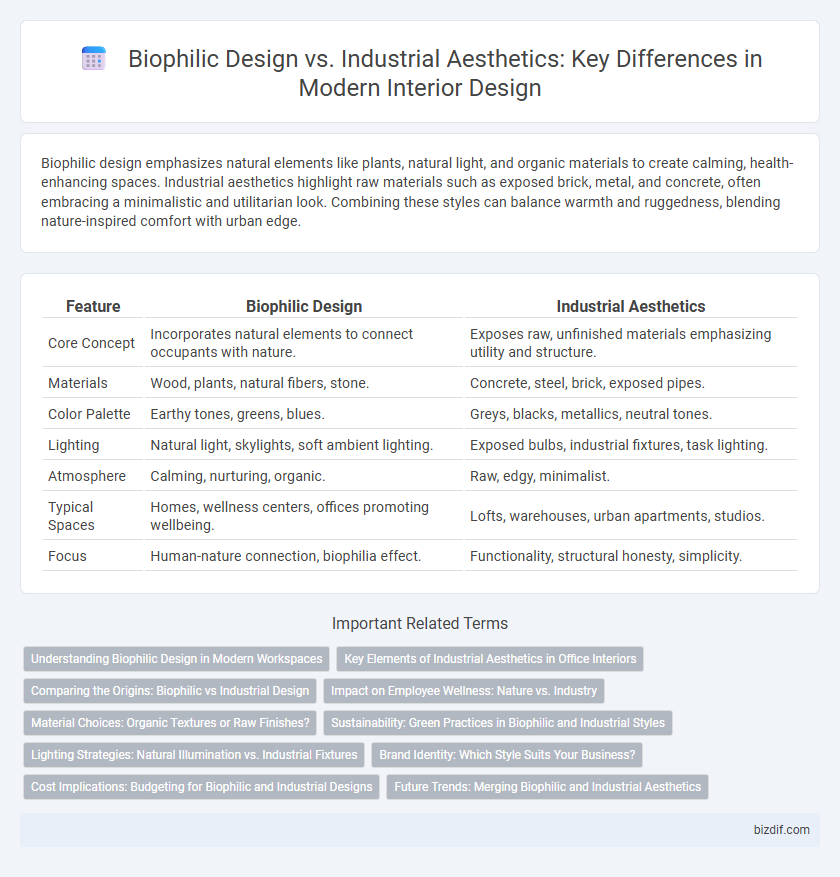Biophilic design emphasizes natural elements like plants, natural light, and organic materials to create calming, health-enhancing spaces. Industrial aesthetics highlight raw materials such as exposed brick, metal, and concrete, often embracing a minimalistic and utilitarian look. Combining these styles can balance warmth and ruggedness, blending nature-inspired comfort with urban edge.
Table of Comparison
| Feature | Biophilic Design | Industrial Aesthetics |
|---|---|---|
| Core Concept | Incorporates natural elements to connect occupants with nature. | Exposes raw, unfinished materials emphasizing utility and structure. |
| Materials | Wood, plants, natural fibers, stone. | Concrete, steel, brick, exposed pipes. |
| Color Palette | Earthy tones, greens, blues. | Greys, blacks, metallics, neutral tones. |
| Lighting | Natural light, skylights, soft ambient lighting. | Exposed bulbs, industrial fixtures, task lighting. |
| Atmosphere | Calming, nurturing, organic. | Raw, edgy, minimalist. |
| Typical Spaces | Homes, wellness centers, offices promoting wellbeing. | Lofts, warehouses, urban apartments, studios. |
| Focus | Human-nature connection, biophilia effect. | Functionality, structural honesty, simplicity. |
Understanding Biophilic Design in Modern Workspaces
Biophilic design integrates natural elements such as plants, natural light, and organic materials into modern workspaces to enhance employee wellbeing and productivity. This approach contrasts with industrial aesthetics, which emphasize raw materials like exposed brick, metal, and concrete, focusing on functionality and minimalism. Understanding biophilic design involves recognizing its impact on reducing stress, improving air quality, and fostering creativity within contemporary office environments.
Key Elements of Industrial Aesthetics in Office Interiors
Industrial aesthetics in office interiors emphasize raw materials such as exposed brick, concrete floors, and visible ductwork, creating an authentic, utilitarian feel. Key elements include open layouts that showcase structural components, metal fixtures, and neutral color palettes dominated by grays, blacks, and browns. Incorporating reclaimed wood and vintage industrial lighting adds warmth while maintaining the rugged, functional character essential to the industrial design style.
Comparing the Origins: Biophilic vs Industrial Design
Biophilic design originates from a desire to reconnect humans with nature, incorporating natural elements such as plants, natural light, and organic materials to promote well-being. Industrial aesthetics emerged from repurposed urban warehouses and factories, emphasizing raw textures like exposed brick, metal, and concrete to evoke a rugged, utilitarian charm. While biophilic design fosters a sensory connection to nature, industrial design highlights functional and historical elements of industrial spaces.
Impact on Employee Wellness: Nature vs. Industry
Biophilic design enhances employee wellness by incorporating natural elements such as plants, natural light, and organic materials, which have been shown to reduce stress and boost productivity. In contrast, industrial aesthetics emphasize raw materials like exposed brick, metal, and concrete, creating a sleek, functional environment but often lacking the restorative benefits tied to natural settings. Studies indicate that workspaces integrating biophilic elements foster greater mental well-being and creativity compared to purely industrial-themed interiors.
Material Choices: Organic Textures or Raw Finishes?
Biophilic design emphasizes organic textures such as natural wood, stone, and plant-based materials to create a sense of connection with nature, enhancing wellbeing and comfort. Industrial aesthetics prioritize raw finishes like exposed concrete, metal, and reclaimed wood, highlighting utilitarian and rugged elements for a modern, edgy atmosphere. Choosing between these approaches depends on whether the goal is to evoke warmth and natural harmony or to celebrate industrial authenticity and structural honesty.
Sustainability: Green Practices in Biophilic and Industrial Styles
Biophilic design emphasizes sustainability through the integration of natural materials, living plants, and energy-efficient solutions that promote indoor air quality and reduce carbon footprints. Industrial aesthetics incorporate sustainability by repurposing reclaimed wood, metal, and vintage fixtures, minimizing waste and encouraging adaptive reuse. Both styles prioritize eco-friendly practices but differ in execution, with biophilic design focusing on nature's restorative qualities and industrial design highlighting resourcefulness and durability.
Lighting Strategies: Natural Illumination vs. Industrial Fixtures
Biophilic design emphasizes natural illumination through expansive windows, skylights, and strategically placed openings to maximize daylight and enhance well-being. Industrial aesthetics prioritize functional lighting with exposed bulbs, metal fixtures, and pendant lights that create a raw, utilitarian ambiance. Integrating natural light with industrial fixtures balances warmth and practicality, fostering an inviting yet edgy interior environment.
Brand Identity: Which Style Suits Your Business?
Biophilic design enhances brand identity by incorporating natural elements like greenery, natural light, and organic materials, fostering wellness and sustainability that resonate with eco-conscious customers. Industrial aesthetics emphasize raw materials, exposed structures, and minimalist forms, projecting a bold, modern, and edgy brand personality suitable for tech startups and creative industries. Choosing between these styles depends on whether your business values warmth and connection to nature or a sleek, urban, and innovative image.
Cost Implications: Budgeting for Biophilic and Industrial Designs
Biophilic design often involves higher initial costs due to natural materials, greenery integration, and specialized lighting that enhance well-being and indoor air quality. Industrial aesthetics typically require lower upfront investment, focusing on raw elements like exposed brick, metal, and concrete that are cost-effective and easy to maintain. Budgeting for biophilic design needs to account for ongoing maintenance of plants and natural components, while industrial design emphasizes durable, low-maintenance finishes, reducing long-term expenses.
Future Trends: Merging Biophilic and Industrial Aesthetics
Future interior design trends emphasize the fusion of biophilic design and industrial aesthetics, creating spaces that balance natural elements with raw, urban materials like exposed steel and concrete. Integrating greenery, natural light, and organic textures into industrial frameworks promotes wellness and sustainability while maintaining a minimalist, edgy look. Smart technology and sustainable materials further enhance this hybrid style, reflecting a growing demand for environments that connect occupants to nature without sacrificing modern functionality.
Biophilic design vs Industrial aesthetics Infographic

 bizdif.com
bizdif.com